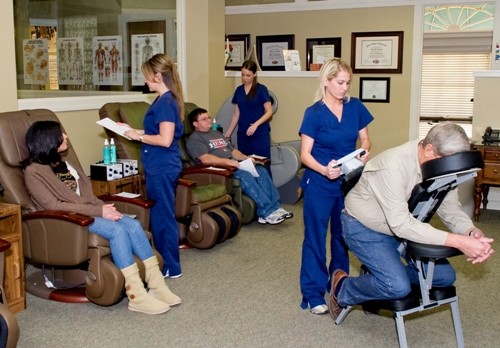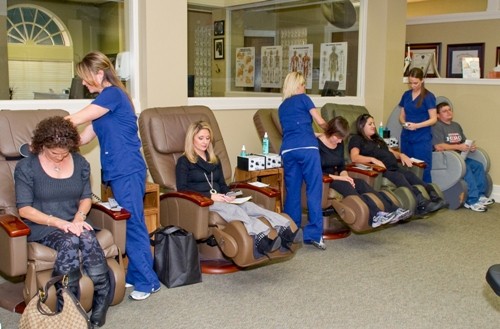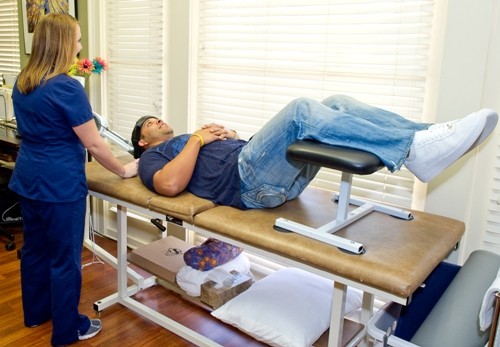Physiotherapy Modalities

Electrical Muscle Stimulation speeds healing time by flushing out painful inflammation. It also helps to break unwanted fibrotic tissue, allowing injured muscles to heal more completely. You will notice an immediate pain reduction through the stimulation of the nerve fibers, which distracts them from the pain.
ULTRASOUND THERAPY
Ultrasound is the application of sound waves above human hearing to tissue to increase healing in an area. Ultrasound that is applied to an injured area provides a "micromassage" or a vibration at the cellular level. This treatment decreases pain, increases flexibility, and speeds the healing process. This treatment also assists in the breakup of scar tissue formation. Ultrasound may also cause mild heating to occur in the area, depending on how it is applied.
Like exercise, each treatment of ultrasound builds on the previous session, so more than one treatment is necessary to gain the effects; usually 5-8 treatments are used at the minimum. Your treatment will last from 1-8 minutes, and you will need to be treated either daily or every other day. On occasion more extensive ultrasound treatments may be recommended, up to 4-6 weeks.
When properly applied, ultrasound will cause almost no sensation at all, although mild warmth may be felt on the skin and sometimes deeper in the tissue. If at any time during the treatment you feel a burning or aching sensation, let you clinician know immediately; the intensity of the treatment may be more than it should.
The use of cold in therapy, or cryotherapy, is often applied to a new injury or a recently re-injured old injury to decrease pain, muscle spasm, and swelling. Ice slows blood flow to the injured area and minimizes damage done by interrupted circulation. Ice is the safest and most effective way of treating sprains, strains, muscle spasm, and bruises. We frequently prescribe ice for a wide range of muscle and joint complaints. If you are not sure if you should use ice or heat, you should use ice.
What you will feel:
When ice is properly applied, the following sensations will occur during a normal treatment:
- Cold
- Increasing discomfort or aching feeling
- A painful or burning sensation
- Numbness or significant pain reduction
The first time you apply ice, it can be very uncomfortable, but each treatment will get easier as you get used to the ice application.
Home Application:
The easiest, safest, and most effective way of applying ice at home is to use a plastic bag half filled with ice cubes and wrapped in a single layer of damp towel. Our office also has home ice packs available for patients. The ice should be applied directly over the injury and left on for a period of 20 minutes. It can be reapplied as necessary so long as there is a 60 minute wait between applications to allow the temperature of the injured tissue to return to normal. Generally, the application of ice to a new or recently aggravated injury is most effective in the first 24-72 hours.
 MOIST HEAT THERAPY
MOIST HEAT THERAPYMoist Heat is very relaxing to the body. It promotes healing through increased circulation.
Heat application helps relax tight muscles, and increases blood flow and nutrition to the area, which can help speed healing once the initial inflammation has subsided. It also helps the muscles and tendons respond better to being stretched and exercised. This treatment should feel like gentle warmth, never hot or burning.
If you use heat application at home, a treatment time of 20 minutes (no longer) is recommended. Leave the heat off for an hour or so between treatments. It should be understood that heat cause dilation of the blood vessels and can increase inflammation with new injuries. Use this type of therapy under the advice of your treating physician.
Do not use any kind of heat on a new (within 3 days) injury. Although the heat will probably feel good at the time, it actually slows the healing process and may cause increased aching and pain a few hours after treatment. For the first 2 to 3 days after an injury, ice is a better choice.
Moist Hot Packs
Moist hot packs are a convenient and effective way of treating with heat. Over the course of the 20-minute treatment, it may make you sweat, but it should never feel uncomfortably hot or burning. If it does feel too hot, let your doctor know immediately. At first you will barely feel the warmth, but it will gradually get warmer during the first 10 minutes.
The advantage of moist heat over dry heat is that moist heat penetrates deeper, so generally moist heat is preferable except for people with arthritis.
 CERVICAL & LUMBAR TRACTION
CERVICAL & LUMBAR TRACTION
Traction is a nonsurgical method that effectively treats disabling low back, neck, radiating leg & arm pain, and headaches. Traction Therapy effectively relieves pain associated with disc herniation, degenerative discs, posterior facet syndromes, by reducing the pressure on spinal discs and facet joints through unloading created by distraction and positioning. Traction Therapy effectively enhances the healing process and renders quick, effective and amazing pain relief that enables most patients to return to a more active lifestyle.
Reversed Cervical Traction helps to restore proper neck biomechanics and return normal function to the spine, preventing degenerative processes. This helps eliminate neck pain and headaches, allowing you to feel like yourself!
Lumbar "Flexion Distraction" Traction helps to decrease pressure in the lower back, allowing the injured tissues to heal. This is especially beneficial for disc herniations in the lumbar spine.